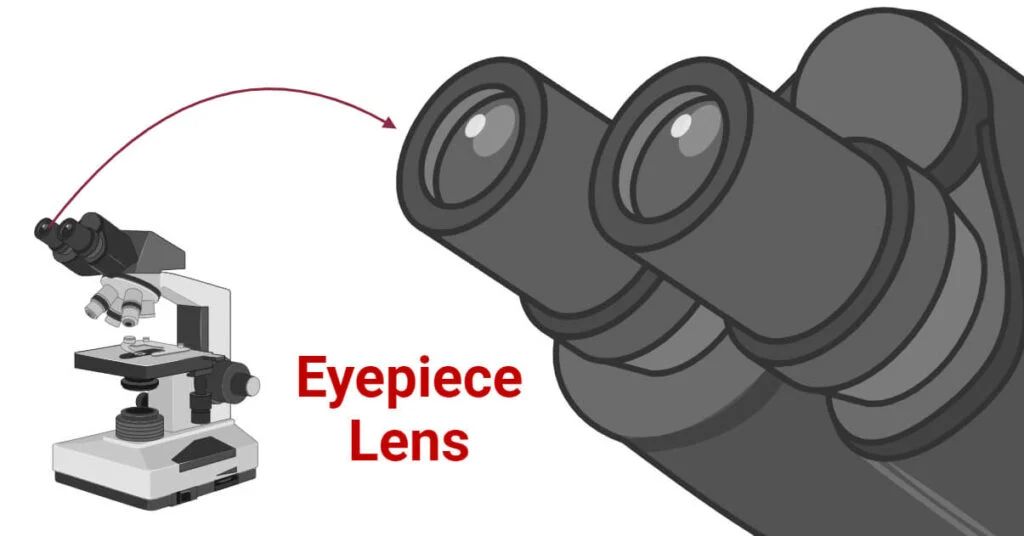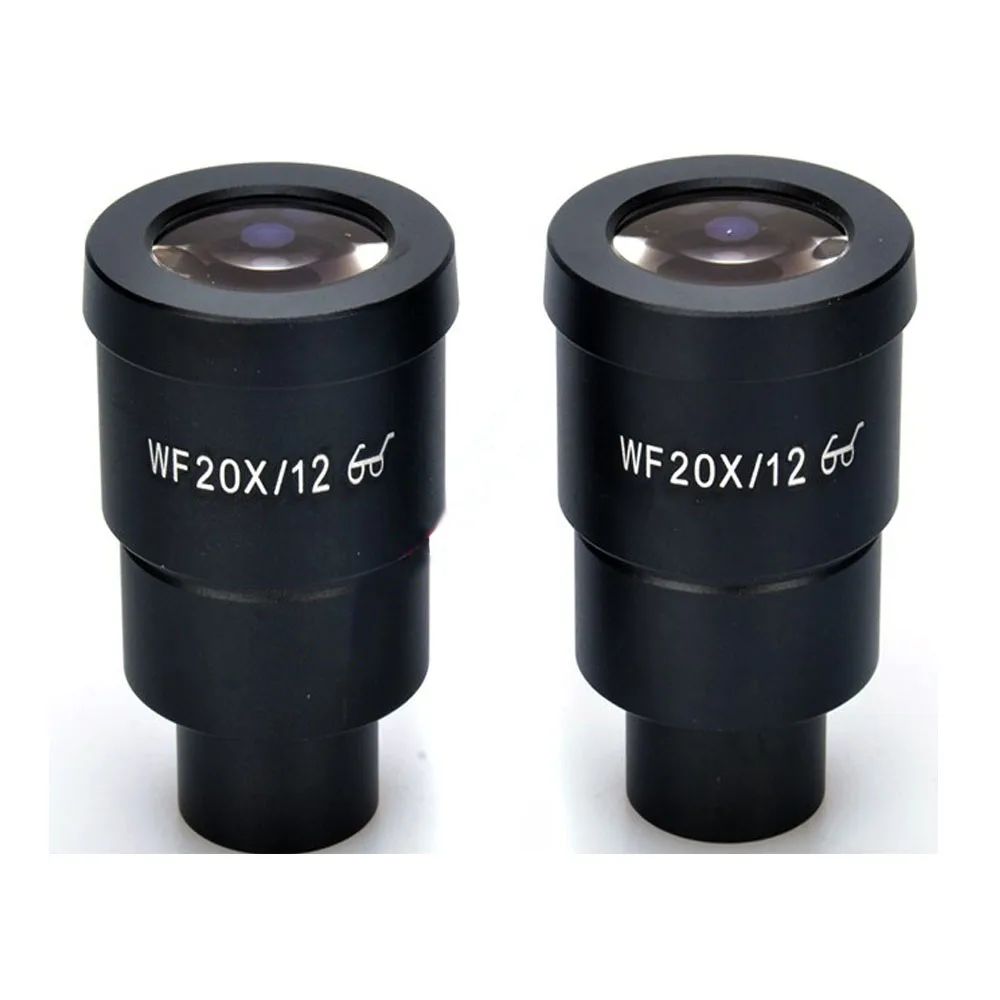Introduction
In the fascinating world of optics and microscopy, the eyepiece lens plays an indispensable and critical role in enabling the observer to clearly view minute structures that are otherwise invisible to the naked human eye. Whether you’re peering into the miniature universe of a basic school microscope or using a highly sophisticated and technologically advanced research-grade optical instrument, it is always the eyepiece that ultimately delivers the final magnified image to your eye.
Often referred to as the ocular lens, this optical component is the last stage through which light passes before it reaches the observer’s eye. Although the eyepiece may appear to be a simple component at first glance, its construction, optical design, and primary function are essential for achieving sharp, high-resolution, and comfortably viewable images.

This comprehensive guide explores the eyepiece lens in great detail. It presents an in-depth explanation of its definition, explores its structural components, describes its essential functions, outlines its various types, and offers practical tips for proper care and maintenance. Whether you’re a student learning the basics of microscopy, a teacher guiding young minds, a scientist conducting research, or a hobbyist exploring the microscopic world, a solid understanding of the eyepiece lens will significantly enhance your experience and appreciation of how optical systems function.
Table of Contents
Definition of Eyepiece Lens
An eyepiece lens, which is also known as an ocular lens, is a specially designed lens that is attached to the upper end of optical instruments such as microscopes and telescopes. It is the part of the optical device that is positioned closest to the observer’s eye and is responsible for magnifying the image formed by the objective lens or mirror. Essentially, the eyepiece takes the intermediate image created by the primary lens system and further enlarges it so that the human eye can see fine structural details with clarity.

Eyepiece lenses are manufactured in a variety of configurations, each tailored to meet specific observational needs. They come in different magnification levels, such as 5x, 10x, 15x, or 20x, with 10x being the most commonly used in standard microscopy applications. The choice of magnification can affect not only the total enlargement of the image but also the field of view, clarity, and comfort of viewing. In addition to their magnifying role, eyepieces also contribute to image correction, help reduce distortion, and improve the overall optical performance of the instrument.
Parts of the Eyepiece Lens
Although the eyepiece may look like a simple tube from the outside, it consists of several carefully engineered internal components that work together to ensure high-quality image delivery and comfortable viewing.
1. Eye Lens
This is the lens element that is closest to the eye of the observer. It is designed to produce the final image that the viewer sees and plays a crucial role in determining the image quality. A well-crafted eye lens provides a sharp image, wide field of view, and sufficient eye relief to reduce eye strain, making extended observation more comfortable.
2. Field Lens
Located near the bottom of the eyepiece barrel, the field lens assists in focusing the image and increasing the field of view. It contributes to image clarity by helping to direct the light rays efficiently through the eyepiece, thereby ensuring that the final image is well-illuminated and evenly bright across the entire field.
3. Lens Barrel
The lens barrel is the cylindrical housing that holds the various lens elements in proper alignment. Made from durable materials like metal or reinforced plastic, the barrel ensures the structural stability of the eyepiece and protects the lenses from damage due to dust, moisture, or impact.
4. Eye Cup
The eye cup is a protective and comfort-enhancing ring made of soft rubber or plastic that is located at the top of the eyepiece. It serves to cushion the eye during observation and blocks out stray light from the surroundings, thereby improving contrast and visibility, especially in bright environments.
5. Diopter Adjustment Ring (optional)
Some high-end or binocular eyepieces include a diopter adjustment feature. This allows users to fine-tune the focus of each eyepiece individually, compensating for differences in vision between the observer’s two eyes. This is particularly useful for users with unequal eyesight.
6. Reticle (optional)
A reticle is a fine etched grid or scale that is sometimes integrated into the eyepiece lens. It is used for measuring distances, sizes, or for aligning the view precisely during microscopy. Reticles are particularly valuable in scientific and engineering applications where accuracy is essential.
Functions of the Eyepiece Lens
The eyepiece lens does much more than just magnify an image. Its role is multifaceted and indispensable for effective and efficient observation through any optical instrument.
1. Magnification of the Image
The eyepiece works in conjunction with the objective lens to magnify the image of the specimen. For instance, a 10x eyepiece used with a 40x objective lens results in a total magnification of 400x. This allows detailed examination of structures that cannot be seen with the naked eye.
2. Improvement of Image Clarity and Sharpness
High-quality eyepieces enhance image resolution by minimizing optical distortions such as chromatic aberration, field curvature, and spherical aberration. This leads to a crisper, more accurate representation of the specimen.
3. Comfortable and Prolonged Viewing
A well-designed eyepiece provides adequate eye relief, which is the optimal distance from the eyepiece to the eye for seeing the full image. Long eye relief reduces eye fatigue and allows observers to work comfortably for extended periods, even when wearing glasses.
4. Wider Field of View
The eyepiece influences how much of the sample area can be viewed at once. Wide-field eyepieces expand the visual field, which is useful for scanning large specimen areas or viewing multiple structures simultaneously.
5. Facilitating Measurements and Calibration
Eyepieces equipped with measuring tools such as micrometers or reticles allow for precise measurement of specimens. This is essential in scientific, industrial, and clinical settings where accuracy is key.
6. Flexibility and Customization
Because eyepieces are interchangeable, users can choose the magnification and field of view best suited to their task. This adaptability makes them useful for a wide range of applications and personal preferences.
Types of Eyepiece Lenses
Different observational needs require different types of eyepiece lenses. Here are the most common types:
1. Huygens Eyepiece
This basic eyepiece design includes two plano-convex lenses and is often found in entry-level microscopes. While it is affordable and simple to use, it offers limited image correction and is best for general educational use.
2. Ramsden Eyepiece
An improvement over the Huygens design, the Ramsden eyepiece places the lenses closer together, providing better image quality. It is used in both educational and amateur scientific applications.
3. Wide-Field Eyepiece (WF)
Wide-field eyepieces allow for a larger viewable area, making them ideal for scanning slides and observing larger specimens. They are standard in many biological and clinical microscopes.
4. Super Wide-Field Eyepiece (SWF)
These provide an even more extensive field of view than regular wide-field eyepieces. They are useful in disciplines like entomology, paleontology, and pathology where viewing extensive detail is necessary.
5. Compensating Eyepiece
These specialized eyepieces are designed to correct for optical flaws introduced by high-powered objective lenses. They are important for maintaining image quality in professional microscopes.
6. Zoom Eyepiece
These eyepieces allow users to adjust magnification smoothly without switching lenses. They are ideal for dynamic applications where variable zoom levels are required.
Care and Maintenance
Proper care is vital to maintain the performance and longevity of the eyepiece lens.
1. Cleaning
Always clean gently using appropriate tools:
- Start by blowing off dust with an air blower.
- Use a soft brush to dislodge particles.
- Clean with a microfiber cloth and specialized lens solution, wiping in circular motions.
2. Storage
Store the eyepiece in a clean, dry, and dust-free environment:
- Use a dust cover over the microscope.
- If removable, keep the eyepiece in a padded case.
- Avoid storing in humid areas to prevent fungal growth.
3. Handling
- Always hold the eyepiece by its barrel.
- Avoid touching the lens surfaces.
- Handle with both hands when transporting microscopes.
4. Inspection and Maintenance
- Regularly check for cloudiness, scratches, or misalignment.
- Replace damaged parts promptly to avoid poor image quality.
Conclusion
The eyepiece lens is a vital and often underestimated component of optical instruments. Far from being just a magnifier, it contributes to image quality, viewing comfort, and operational flexibility. By understanding its construction, function, and care, users can make informed choices and ensure their optical systems deliver optimal performance.
FREQUENTLY ASKED QUESTIONS
What is an eyepiece lens?
An eyepiece lens, also known as an ocular lens, is the part of a microscope or telescope that you look through. It magnifies the image produced by the objective lens.
Why is the eyepiece important?
It helps to enlarge the intermediate image formed by the main optical components and makes it visible and clear for the human eye.
What are the main parts of an eyepiece?
The main parts include the eye lens, field lens, lens barrel, eye cup, and sometimes additional components like a diopter adjustment ring or a reticle.
Related Articles




